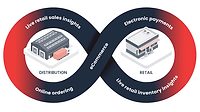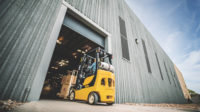![]()
The Future of Transportation
This month, Beverage Industry welcomes transportation expert
David Kolman to the magazine. As a veteran truck communicator, keynote speaker
and long-haul trucker, David is an involved member of the transportation industry.
Commissioned an Honorary Colonel on the Kentucky governor’s staff for his work
promoting traffic safety, he participates in trade associations and reports
news and information about the trucking industry for broadcasting and print
media.
To begin, let me welcome you to this new column. My purpose
is to provide you with vital news, information and ideas to help you maximize
your transportation efforts.
The starting point for this inaugural column is to
take a look ahead. No easy task, as trying to predict the future is a lot
like having gas. You know it’s coming, and you have to figure out
what to do about it. By gaining insight into tomorrow we can better plan
for the future because we will know what we are planning for.
Having consulted horoscopes, tea leaves, tarot cards,
crystal balls and a number of seasoned transportation industry
professionals, I offer some predictions.
Tires
Development and evolution of wheel position- and
application-specific tires, “smart” tires and tire systems will
continue because they help reduce tire management costs — the
second-largest variable cost for truck fleets.
New tire designs, technologies, innovations and
advanced tread compounds will provide such benefits as better fuel economy,
enhanced performance, extended original tread life, maximum retreadability,
increased payload and improved vehicle stability and control.
Look for wheel-specific tire pressure sensing systems;
air pressure equalizer systems for dual tires,
some of which automatically isolate the good tire in the event of a
blowout, and in a slow-leak situation, isolate the other tire after a small
pressure drop; tire inflation systems which automatically monitor and
maintain inflation levels; in-wheel pressure and temperature sensors, and
run-flat tires. Benefits of such systems include improved vehicle handling
and safety; increased tread and tire life; enhanced fuel efficiency, and
reduced downtime and roadside delays for tire failures — and the
driver frustrations that come with these.
Expect to see more integrated tire management systems
similar to Michelin’s eTire System. It incorporates an in-tire
sensor, sidewall-mounted sensor dock, reader (hand-held or drive-by) and
software to capture and instantly report tire pressure, wheel position and
maintenance information. The sensor is a small, battery-less device that
senses pressure and temperature. The reader is used to wirelessly
communicate with the sensor to read the digital pressure, temperature and
identification information. Using the software, this gathered information
is reported in a fleet specific manner via an Internet server to enable
managers to track tire costs accurately and monitor inventories.
Engines
Increasingly stringent emission regulations in the
United States, as well as around the world, will keep on impacting engine
designs, particularly diesels. Scheduled to take effect in 2007 and 2010,
new regulations for the commercial vehicle industry demand that particulate
matter and oxides of nitrogen emissions be reduced by 90 to 95 percent from
current levels. Similarly, stricter European standards will be mandated in
2005 and 2008.
To comply, it is anticipated that all manufacturers
will need to implement a combination of exhaust after-treatment systems
with engine design and control changes.
The jury is still out on how the new
emissions-compliant heavy-duty diesels will perform. Reliability,
driveability, performance, fuel consumption, operating and maintenance
costs will be determined through time and experience. One sure prediction:
these engines will cost more. Estimates range from $6,000 to $10,000.
As for the 2007 low-emissions medium-duty diesels,
they are expected to have improved performance and more power and torque
than their predecessors, but fuel economy will suffer somewhat. These new
engines will also come with a higher price.
Meantime, research and development of advanced
propulsion systems — such as diesel hybrid electric and hydrogen
fuel-cell technology — is going to continue. The U.S. Postal Service
and FedEx are currently investigating gasoline hybrid electric light-duty
vehicles.
Trucks
Trucks of the future will have more sophisticated,
lighter-weight designs and be more electronically complicated. They will be
more comfortable, safer to operate, have greater durability and longevity
and be less expensive to operate and maintain. Expect maintenance-free
vehicles for the first million miles.
Electronics, telematics (wireless, two-way
communication between a vehicle and its environment), new technologies,
satellites and mobile communications will cause more significant changes in
trucks and trucking.
We will see systems to prevent vehicle rollovers.
Fingerprint ID ignition switches will deter vehicle theft and increase
security.
Systems will allow fleets to monitor the location and
progress of their trucks; track vehicle speed, fuel consumption, idling,
shifting and braking patterns and mechanical status; alert drivers and
fleet managers about impending engine problems before breakdowns occur, and
provide real-time diagnostics.
There will be systems that reward good drivers and
punish bad ones. For example, safe and efficient drivers could be given
more speed and horsepower, while bad drivers would get less. Advances will
lead to systems that provide detailed turn-by-turn driving directions along
with detailed, full-color maps and continual updates of ongoing road
changes and restrictions. Other systems will incorporate mobile computing
devices and interfaces to more efficiently manage such tasks as pre-sale
order entry, driver-sale, merchandising, delivery and inventory control.
Drivers
The challenge of attracting and retaining qualified,
safe drivers and driver route salespeople will remain. Some ways to address
the situation would be to develop a good compensation package (salary,
benefits, incentives, bonuses, safety and recognition programs), establish
good communication (open-door policy to management, newsletters, pay
envelope inserts, bulletin boards); create honest and positive orientation
programs, and provide regular training.
Information
Your job will become more challenging. Along with
trying to stay on top of your ever-demanding duties and responsibilities,
you will have to contend with the accelerating pace of innovation, new
technologies, regulatory changes, changing distribution methods and
strategies, ever more complex trucks and equipment, and changing
maintenance products and practices.
Complicating matters further, our ability to produce
information and deliver it 24 hours a day is outstripping our ability to
process it. Information glut — or infoglut, as it’s come to be
known — has been steadily growing, as has the stress to the psyche.
Those who will be the most successful in the future will be
the ones who do not drown in information, but rather find knowledge through
sorting out what information is essential, analyzing it and then figuring out
how best to use it.



